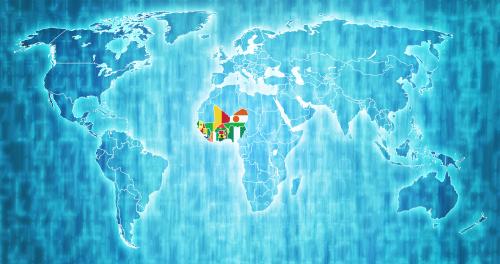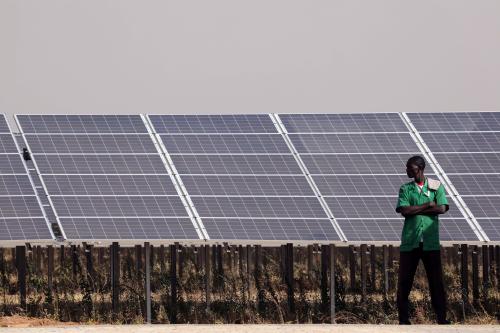The current pace of globalization gives no choice to small developing countries: they must integrate into world markets if they wish to succeed. Africa has more than its fair share of small poor economies because of fragmentation that it inherited from European colonizers, making Africa the continent most prone to ethnic-based conflicts. Yet, African countries impose the heaviest artificial barriers around their borders on top of this. It’s time to change this.
Go sub-continental
Except for the two dominant economies––South Africa and Nigeria––the continent is made up of countries that have small domestic markets, limited economic diversification, and generally poor connectivity with neighboring countries, reducing proximity between economic agents within Africa, and between Africa and the rest of the world. Yet, the approach of the international community (specifically, developed countries and international financial institutions) to help Africa has so far been essentially country-specific, and putting out regional fires that threaten to become global: genocides, pandemics, religious conflicts, etc.
This approach has merits, but a continent suffering on a permanent basis from the triple disadvantages of low economic density, long distance to markets, and deep divisions needs a different strategy. My research indicates that it would benefit enormously from a regional approach, as argued by the World Development Report 2009.
One way to do this is by granting preferential access to leading world markets to the region, as intended by the African Growth Opportunity Act (AGOA) and Everything But Arms (EBA), two preferential agreements extended by the United States and the European Union, respectfully, since 2001. But not all African countries have benefited from this access, among which are West African countries. Paradoxically, West Africa hosts two of the most advanced regional economic communities. The West African Economic and Monetary Union (WAEMU) shares a common monetary policy that has held inflation down and constitutes a customs union with a compensation mechanism to uphold the Common External Tariff. The Economic Community of West African States (ECOWAS) maintains a regional military force and exerts peer pressure that has rooted out military coups in its member countries. Obviously, something more is needed.
In a recent working paper, I do some back-of-the-envelope simulations derived from estimated coefficients of a Pseudo Poisson Maximum Likelihood gravity model estimation using disaggregated export data between 2001 and 2015. (Coulibaly, S., 2017: “Differentiated Impact of AGOA and EBA on Western African Countries,” Africa Chief Economist Office, the World Bank.) West Africa could be exporting 2.5 to four times more to the EU and the U.S. were AGOA and EBA not implemented in a differentiated manner in terms of country eligibility, product coverage, and rules of origin.
Needed: A very different Berlin Conference
Given such a trade creation potential for countries committed to deep regional integration, a revision of AGOA and EBA or a special ECOWAS/WAEMU provision could make these preferential trade agreements a driving force behind regional integration dearly needed in sub-Saharan Africa.
More generally, in the spirit of the G-20 “Compact With Africa” (CWA) spearheaded by Germany, a complementary Aid-for-Trade initiative focusing on ECOWAS/WAEMU (hosting three countries of the compact: Cote d’Ivoire, Ghana, and Senegal) could accelerate export from these economies. It will also trigger three channels of regional spillovers:
- A distribution effect from West African CWA countries to their regional economic partners within West Africa (e.g., Nigeria could be a major beneficiary) and outside (Cameroon could be a major beneficiary) through trade in goods and services and cross-border labor and capital flows.
- A domino effect inciting countries close to ECOWAS/WAEMU to join the integration process to take advantage of the new economic opportunities generated by the coordination of foreign aid. Morocco’s recent application for ECOWAS membership confirms the relevance of such domino effect.
- A demonstration effect encouraging other subgroups to deepen their regional integration processes to take advantage of the coordinated CWA and Aid-for-Trade initiatives. For instance, countries like Cameroon and Gabon could set aside longtime rivalries and take the lead in the regional integration effort in Central Africa.
Six steps to success
With the demonstration effect from ECOWAS/WAEMU, the international community could shift to a “contract with African neighborhoods” involving leading and lagging countries of the neighborhoods as well as the donors’ community providing the right incentives to ensure developmental regional cooperation initiatives. For instance, the governments of East, Central, South, and West African neighborhoods could commit to:
- Establishing “African Economic Areas” that would tie the economic interests of leading and lagging countries in each regional neighborhood tightly together.
- Allowing and maintaining the free movement of labor, capital, goods, and services within these areas.
- Maintaining and protecting access routes between land-locked countries and outlets for trade, and providing the political space to support investment in regional infrastructure.
In exchange for these actions, bilateral and multilateral development partners could commit to:
- A big increase in aid for improved social services and other life-sustaining infrastructure aimed at raising living standards and creation of portable human capital in lagging countries.
- Increased financial support for growth-sustaining infrastructure—ports, transport links, information and communication technology—in the leading countries where economic takeoff is most likely, as well as infrastructure to link the markets of large leading countries with labor, capital, goods, and ideas in smaller neighbors.
- Preferential access to the markets of high-income countries for sub-Saharan Africa’s exports, without strict rules of origin or eligibility criteria that impede rapid growth of trade in intermediate inputs with other developing economies.
Disclaimer: This blog post reflects the personal views of the author and does not represent the position of the World Bank Group. The working paper can be requested by writing [email protected].
The Brookings Institution is committed to quality, independence, and impact.
We are supported by a diverse array of funders. In line with our values and policies, each Brookings publication represents the sole views of its author(s).







Commentary
Six steps to start changing how Africa does development
July 19, 2017